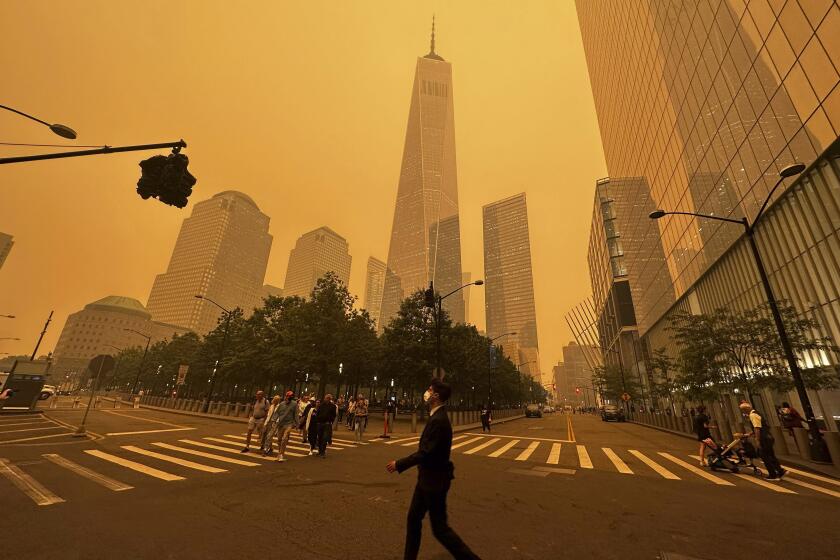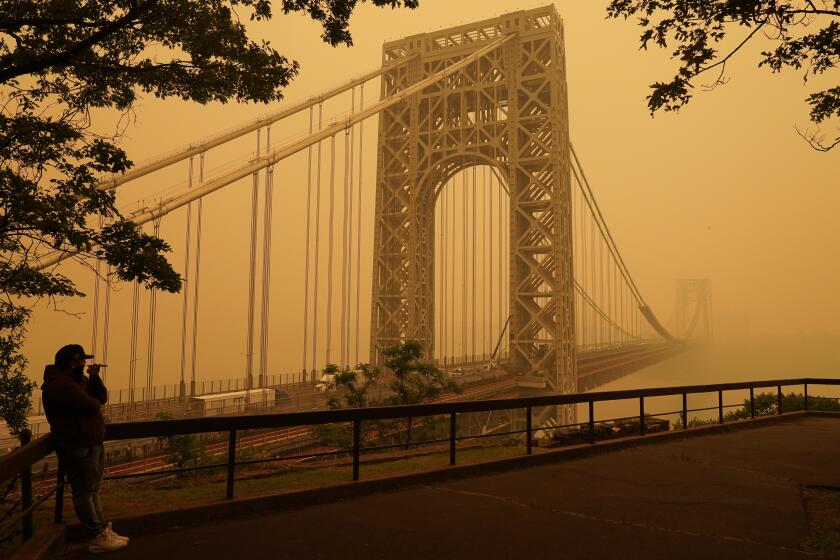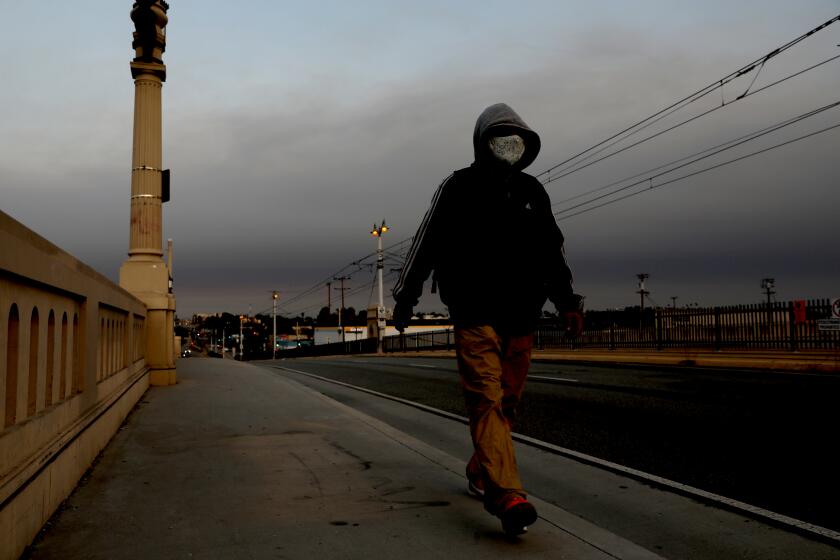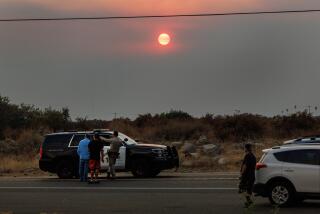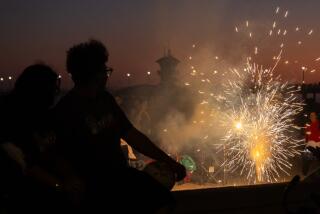Wildfire smoke has given New York the world’s worst air quality. Californians have some tips
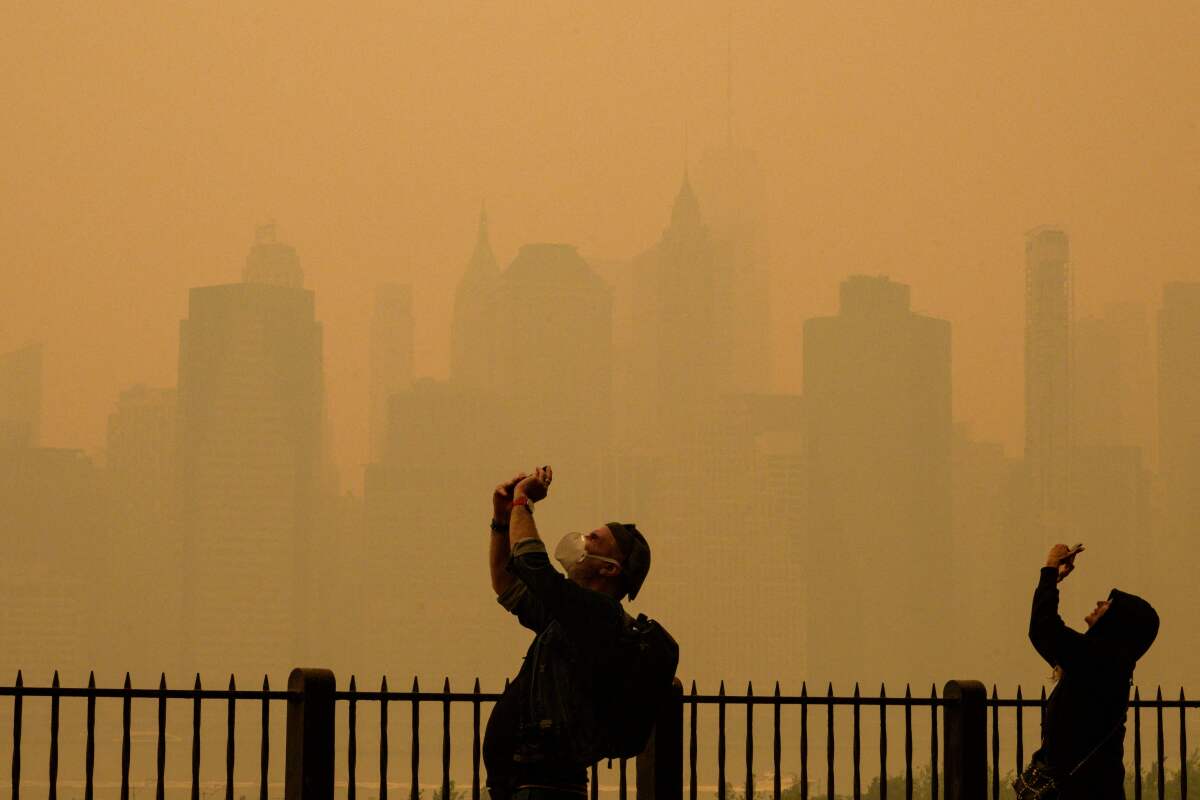
NEW YORK — Download smartphone apps to monitor the air quality index. Buy some air purifiers. Put on that KN95 mask. Just because you can’t see the threat doesn’t mean it’s not there.
West Coasters who have long lived with the danger of wildfires offered some words of wisdom to their East Coast counterparts Wednesday, as residents along the Eastern seaboard faced another dizzying day of hazy skies amid smoke and air pollution from wildfires burning in Canada.
Tens of millions of Americans were under air quality alerts, stretching from parts of western Missouri to New York, from Maine to South Carolina, where particulate levels were expected to enter unhealthful territory and many residents experienced the scratchy throats and irritated eyes and lungs that wildfire smoke can cause.
By afternoon, the IQAir World Air Quality Index ranked New York City No. 1 for the worst air quality on the planet for the second straight day, ahead of global cities such as New Delhi, where such conditions are more common.
The air quality index in New York continued to deteriorate as the day went on, soaring from below 200 to above 400 by late afternoon, according to AirNow.gov, which offers real-time tracking of AQI. New York City Mayor Eric Adams said that at 5 p.m., the AQI had hit 484, “the highest level index of our knowledge since the ‘60s.”
Values of 301 or higher are considered hazardous, a level at which the Environmental Protection Agency warns that everyone is more likely to be affected, spurring a health warning of emergency conditions.
Smoke from Canadian wildfires poured into the U.S. East Coast, holding up flights at major airports and prompting people to fish out face masks.
The conditions were predicted to worsen into Thursday, with a reprieve expected Friday, but Adams warned that the situation is changing daily.
“Smoke predictability that far out is low,” he said. “We cannot provide guidance more than a day in advance at this point.”
He continued to advise vulnerable residents, including older New Yorkers, those with heart and breathing problems and children, to stay indoors and wear high-quality masks if they needed to venture outside.
Gov. Kathy Hochul said that approximately 1 million N95-style masks would be made available at state-owned facilities.
New York City’s public schools, which were open Wednesday and kept students indoors, will be closed Thursday because of a previously scheduled closure, Adams said.
Beaches would remain closed because of poor visibility, and other outdoor activities around the city would also be canceled, he said, adding that drivers were urged to maintain caution on the roads.
“Our city is strong and resilient,” Adams said. “We have faced crisis before, and we will get through this together.”
Hochul on Wednesday warned residents statewide that the situation was a “crisis” that could last for days.
“This is typically a West Coast phenomena,” she said, emphasizing that people need to stay indoors whenever possible.
Smoke from Canadian wildfires is pouring into the U.S. East Coast and Midwest and covering the capitals of both nations in an unhealthy haze.
The sky in New York grew more ominous and darker during the day as smoke overpowered much of the city, shrouding the five boroughs in a deep, orange glow and disrupting activities, from professional sports to theater.
Wednesday night’s MLB game between the New York Yankees and the Chicago White Sox was postponed one night after the teams faced off under an ashen sky. Another MLB game — this one in Philadelphia, between the Phillies and the Detroit Tigers — was postponed as well, as was a WNBA game between the New York Liberty and the Minnesota Lynx .
A production of Broadway’s “Hamilton” as well as a performance of “Camelot” at New York’s Lincoln Center were canceled. The first two performances of the Free Shakespeare in the Park production of “Hamlet,” which takes place in Central Park, were canceled for Thursday and Friday.
The Federal Aviation Administration said on Twitter on Wednesday afternoon that it slowed traffic to and from New York City area airports “due to reduced visibility from wildfire smoke.” Philadelphia’s airport also was brought to a ground stop, the agency said.
New Yorkers said the smell of smoke, similar to that of a campfire, was so overwhelming that they could not step outside without coughing or their eyes burning. Many wore masks as they commuted across the boroughs and shared photos of the ashen sky from landmarks across the city.
Other parts of the state — and nation — were also blighted by hazardous AQI levels. In Binghamton, which registered 400 AQI before midday, visibility was reduced to just one mile.
In Washington, a haze settled across the National Mall, and the city was under a “code red” alert, triggered when the AQI breaches 150 and vulnerable groups are at particular risk. Parts of Pennsylvania, where its most-populous city of Philadelphia was also under code red, and New Jersey also saw their AQI surpass 400.
The smoke blanketing the East Coast has drifted south from Canada, where nearly 250 active wildfires are scorching the forests around the eastern province of Quebec. High temperatures and dry conditions, along with lightning, ignited the fires, which swelled over the weekend.
An area of low pressure hanging over northern New England is directing the airflow, said John Cristantello, a meteorologist for the National Weather Service’s New York City office.
“The weather pattern is such that the winds just keep funneling down, from generally north to south,” Cristantello said. “We’re sort of a target for the smoke that comes from these fires.”
The weather service said the low-pressure system could shift this weekend, but warned that “as long as the fires continue, the smoke may simply be directed towards other areas of the U.S.”
The air around Southern California feels like smoke soup because of wildfires. What does that mean for your health and daily routines?
Across social media, New Yorkers posted photos of their otherworldly city cast in deep orange, the blood red sunrises and sunsets reminiscent of the skies around Northern California in 2020, when smoke from a variety of fires blanketed the region.
For Sherelle Johnson, a copywriter based in Riverside, the smoky, orange scenes coming out of New York reminded her of the 2020 El Dorado fire, sparked by a gender reveal gone wrong.
“[California] has been through the wildfire season. We have it every year, but not every place has it so bad,” Johnson said, adding the El Dorado fire was especially scary and felt like uncharted territory, even for the most experienced. So Johnson shared tips on Twitter, including advising car owners and homeowners to replace their air filters — now and after the fires.
“They’re doing some heavy lifting right now and you want them effective,” Johnson said. Other tips included keeping windows closed, downloading smartphone apps that measure AQI and making sure to stay hydrated, including your pets.
S.E. Smith, a Northern California-based writer and journalist, cautioned East Coasters against not taking measures to prepare.
“Wildfire smoke doesn’t have to be visible to hurt your lungs,” Smith wrote on Twitter. “Mask up, use an air purifier, and stay indoors if you can. If you feel tired, cranky, or out of sorts, you are probably feeling the smoke!”
Some have pointed out the indifference some New Yorkers have to the constant threat West Coast residents face from wildfires every year — until it knocked on their own door.
“It’s hard to not notice how wildfire smoke is suddenly very important now that New York City residents are experiencing it,” Karl Bode, a Seattle-based writer, said on Twitter. “Seattle looked like ... mordor for several summers, and I recall a lot of yawning on the part of most new york city brunchlords.”
Others said the issue has also become yet another coastal competition. “Why are New York and California beefing over who has worse wildfire smoke,” one Twitter user wrote.
More to Read
Sign up for Essential California
The most important California stories and recommendations in your inbox every morning.
You may occasionally receive promotional content from the Los Angeles Times.
